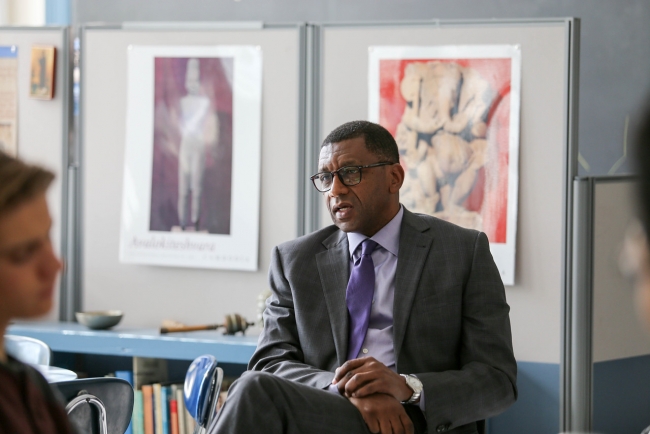Four tips for confronting hate speech at school
October 23, 2023
Children experiencing hate or racial trauma have often told Penn GSE clinical psychologist Howard Stevenson that the most hurtful moment isn’t an actual threat, but when they realized the adults who were supposed to protect them had stayed silent. In the current climate, Stevenson says educators must prepare themselves to speak out.
Helping students who feel under threat is one of the hardest things a teacher or administrator can do. Stevenson offers some ideas for creating safer spaces for students and educators alike.
Start with you
Think of the safety movie they show on airplanes before takeoff. In the event of an emergency, put on your oxygen mask before helping others. It might seem selfish, but educators should take the same approach.
With hateful incidents happening across the country, it’s essential for educators to process their own feelings before they are asked to make decisions, step into a crisis, or help students process an event. Having a support community of other educators who you can be vulnerable with is key.
Practice
Educators are trained in student discipline and classroom management, but hateful actions create an environment few are prepared for. Instead of taking conscious, rehearsed actions, educators often have split-second reactions, not always with the best results.
It’s important to practice or role-play scenarios that you find the most challenging, especially if you experienced a similar incident during your career and don’t believe you handled it well. This doesn’t have to wait for a professional development session. You can practice with a few teachers you trust. Depending on your location, you might have to go beyond your school or even your community for this support, including seeking an affinity group online.
Ask yourselves some big questions. What am I prepared to say? What am I prepared to do? How do I connect it to the pedagogy? If I am teaching history, for example, how is this connected? How do I make this a moment not just for now?
While you are practicing, think of the scenarios where you need to obtain outside help. An educator can’t shrink away from an immediate threat to a student, but he or she doesn’t have to act alone in restoring a sense of justice and order to a school community. Who else would be a resource, either inside your school or from the greater community?
After an incident
How do you engage with a student who writes hateful graffiti on a bathroom wall or calls a classmate a slur? Especially if the incident completely changes how you perceive that student’s character?
First, resist the urge to condemn the student. Instead ask what was behind their action? Explain that the swastika or the N-word has been used to create a dynamic where minorities are meant to feel inferior. Then ask the student, what did he or she expect to get out of writing that on the wall in that moment? What were they looking for? We know that developmentally, a key factor in adolescent identity is striving for power in an effort to avoid non-existence. That needs to be addressed.
Understanding a student’s mindset doesn’t mean excusing his or her actions. The school code of conduct will still come into play. There will still be consequences. But this leaves the door open for teaching, and a potential path for the student back into the community.
Second, explain very strongly that you are going to teach all students how to combat the sense of inferiority the offending student was hoping to create with his or her action. They will not undermine the ability of minorities to stay in this school. They will not silence anyone’s voice. They will not win.
Keep talking
It’s natural for students (and their parents) to be upset after incidents like these, even if they haven’t actually occurred within their school. This is especially true of minority students who might feel targeted. This can lead to difficult conversations. Sometimes, students directly challenge teachers or administrators. And then educators have a choice – they can shut the conversation down or use it as a moment to engage.
I’ve had educators tell me the scariest moments of their careers were when a student — especially a student of color — expressed anger to them. But what if these educators thought of the moment as a gift? What if a student who has been struggling to come to terms with their anger over a hateful incident lashed out because you might be someone who will listen?
So don’t shut the conversation down. Let the student express their anger. In the end, you’ll still be able to have your say. You’ll still be able to tell the student what you didn’t appreciate, and where you disagree. By not using your power in the beginning, you communicate that you are secure enough to handle others being upset. You let the student know their pain and anger is OK, and that you can safely handle it without rejecting the student or their feelings.
Howard Stevenson is a nationally sought-after expert on resolving racial stress and trauma affecting health at every life stage. His work prepares children and adults to assert themselves during face-to-face microaggressions undermining academic and work productivity. Key to this racial healing work is integrating cultural strengths to reduce in-the-moment threat reactions, increase access to memory, physical mobility, and voice, and prevent long-term health detriment. Dr. Stevenson has served for 32 years as a clinical psychologist in under-resourced rural and urban neighborhoods nationwide. His book, "Promoting Racial Literacy in Schools: Differences That Make a Difference," summarizes this work.
An earlier version of this Playbook first ran in 2016; it has been revised in light of escalating violence in the Middle East.


